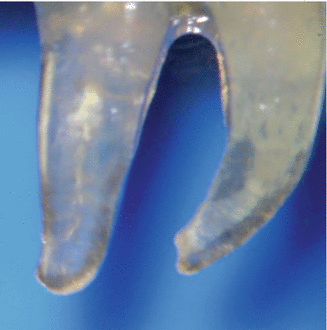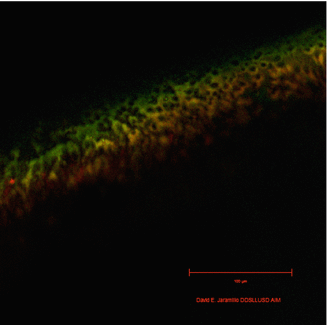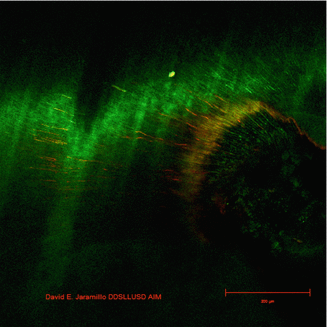Fig. 13.1
SEM image of predentin area. It is evident the presence of bacteria hiding in these areas that remained untouched and unaltered after the cleaning, shaping, and conventional (needle) irrigation of the root canal system
Due to the lack of predictable ways to completely clean and shape the root canal system, the chemical aspect of the root canal therapy is very important. Sodium hypochlorite (NaOCl) was introduced in endodontics in 1920 [37]. Since its introduction into the root canal therapy, NaOCl is considered to be the best irrigation solution used in root canal therapy. It posses excellent characteristics needed during the endodontic procedure as disinfectant, lubricant, and both vital and necrotic tissue dissolvent [38]. On the other hand, van der Sluis [39] found the frequent replenishment of NaOCl during root canal therapy makes the solution more effective, especially when ultrasonic is added as a final rinse of the irrigation protocol.
The acoustic streaming created by ultrasonic irrigation helps in the removal of pulp and dentin debris, microorganism, as well as the smear layer. By applying an ultrasonic force within the root canal, it will create and generate a turbulence that will enhance and produce a better flushing of this debris. Ahmad [18] mentioned the velocity of the streaming could be influenced by factor such as file size, position, and power setting of the ultrasonic unit. He also noticed that the greater streaming activity was found at the level of the minor radius of the file. The smaller the file and the higher the power setting of the ultrasonic unit, the stronger and greater will the streaming velocities be. Williams [40] showed acoustic streaming caused disruption of biological cells.
Newer Laser Technology
PIPS
Photon-induced photoacoustic streaming is based on the radial firing stripped tip with laser impulses of subablative (to evaporized at very low temperature) energies of 20 mJ at 15 Hz for an average power of 0.3 W at 50 μs impulses. The impulses create an interaction of water molecules with peak powers of 400 W. This creates an expansion and successive shock waves leading to the formation of a very powerful streaming of the fluid located inside the root canal, with no rising of temperature.
PIPS is a form of laser-activated irrigation that works indirectly and without thermal effects by activating irrigants. Its mechanism of action is by creating a strong photoacoustic shockwave that streams irrigants three dimensionally throughout the root canal system (Figs. 13.2 and 13.3). Unlike the other conventional laser applications, the unique tapered and stripped PIPS tip is not required to be placed inside the canal system itself but rather in the pulp chamber only. This reduces the need for using larger files and rotary instruments to create larger canal shapes to open the system so that irrigants used during treatment can effectively get to the delicate apical one-third of the root apex, fins, isthmuses, and lateral canals. This nonthermal pressure wave has been shown to effectively remove both vital and necrotic tissues, kill bacteria, remove biofilm, and even disinfect dentin tubules. Peters [41] compared the disinfection and disruption of biofilm within the root canal in the apical third. PIPS did not completely remove bacteria from infected dentinal tubules but did generate less infection and removed biofilm better than passive ultrasonic irrigation technique group.



Fig. 13.2
Streaming acoustic produced by the use of PIPS in this simulated plastic root canal

Fig. 13.3
Natural #30 tooth cleared by diaphanization technique showing the steaming acoustic produced by PIPS reaching the apical portion of the distal root canal
Jaramillo et al. [42] found the combinations of 20 s irradiation with Er:YAG laser via this photoacoustic delivery system PIPS, and 6 % sodium hypochlorite was very effective in inhibiting Enterococcus faecalis growth. The PIPS technology can be used as an efficient additional tool in the decontamination of infected root canals during endodontic treatment (Figs. 13.4 and 13.5). Divito et al. [43] studying the removal of smear layer used PIPS at a wavelength of 2,940 nm with a 12 mm, 400 μm quartz tip at 20 mJs, 15 Hz, and 50 μs pulse duration. Placing the tip stationary in the pulp chamber area only revealed higher quantity of open dentinal tubules when compared to different timing and solutions to just water. Temperature was checked on the outer root surface and an increase of 1.4 °C after a continuous activation of 40 s was found. Heat generation is a very important aspect of laser usage in dentistry. CO2 and Nd:YAG lasers are used as photothermal, the hard tissues surrounding the irradiation area will absorb the laser energy and convert it into heat.



Fig. 13.4
Backlight (live/dead) confocal staining technique. After root canal irrigation with PIPS, the root canal wall and dentinal tubules are free of either live (green) or dead (red) bacteria

Fig. 13.5
Root canal wall and dentin visualization on the presence of live (green) and dead (red) bacteria after conventional (needle) irrigation. Baclight technique
According to Saunders [44], an increment of more than 10 °C for more than 1 min may be sufficient to cause bone tissue injury.
Er:YAG lasers are highly absorbed by water. The penetration depth into enamel and dentin is minimal, and the mechanical ablation process is by micro-explosion without the significant rise in temperature. Sonntag [45] showed pulp histological reaction to Er:YAG laser was similar to that generated by a high-speed handpiece. Armengol [46] compared high-speed carbide bur to Er:YAG at 140 mJ pulse repetition of 4 Hz and Nd:YAP at 240 mJ and a pulse repetition of 10 Hz with and without water. As expected Nd:YAP laser created the higher increment in temperature when compared to Er:YAG laser and high-speed handpiece. This two showed the same parameters of rise in temperature when water spray was used.
Because bacteria can be sensitized to light, Wilson [47] tested light-activated disinfection and obtained good results treating localized bacterial-mediated infections. Following this principle, Lim [48] studied the advanced non-Invasive light-activated disinfection (ANILAD) that is a more efficient type of light-activated disinfection. According to George [49], in order for the photoactivation to be effective, certain factors need to be in place: the interaction of photosensitizer molecules, the physicochemical environment at the site of application, the half-life of the free radicals generated, and the oxygen availability at the site of application. ANILAD improves the penetration into dentinal tubules and the bacterial kill rate. It is also a better oxygen carrier and is less toxic than NaOCl. Unfortunately, the time needed for application is too long and is not clinically convenient at this time. The author found the combination of ANILAD, cleaning, and shaping of the root canal had favorable disinfection rates.
Many studies have been conducted in an effort to understand the behavior of the irrigant solution within the root canal system. Boutsioukis [50] looked at the needle design and clinical realistic flow rate values recorded using virtual studies with computational fluid dynamic models with FLUENT 6.2 software. The flow rate, velocity, and turbulence were recorded. According to the experiment findings, a laminar flow was always detected regardless of the pressure applied to the solution. The maximum velocity was detected near the end of the needle suggesting that the needle should be placed 1 mm short of the working length. The same author [51] studied the formation and removal of the vapor lock during the root canal irrigation when a needle was used following the same type of virtual experiments. Their results showed that there is a direct correlation between the size of the root canal preparation and the size of the needle used and the penetration of the needle to disrupt or avoid vapor lock from occurring. Similar findings made by Hsieh et al. [52] found that the diameter of the irrigating needle and the distance from the working length in instrumented canals will prevent the irrigation solution from reaching the apical portion of the root canal during the cleaning and shaping phase. Shen [53] also studied needle designs and penetration depths at 3 and 5 mm from working length. The results showed that the design of the needle tip influences the flow pattern, flow velocity, and the apical wall pressure. The evidence of needle irrigation demonstrated irrigation solution would not reach the target area. After this evidence, researchers looked into a different direction with respect to the root canal irrigation.
Passive ultrasonic irrigation is defined as the agitation of an irrigation solution located inside the root canal system. This is done with the help of an ultrasonic unit equipped with a small smooth wire oscillating freely inside the root canal system to induce a powerful acoustic streaming [54].
Fincham et al. [55] studied the fluid movements generated with PIPS and ultrasonic irrigation by means of microscopic digital velocimetry. The fluid movement was analyzed directly to the activation probe at 3, 5, 10, and 15 mm distances. On spatial structure, PIPS showed a velocity in excess of 1.2 m/s at 3 mm from the tip. The peak velocity at 5, 10, and 15 mm demonstrated the same range of 0.3 m/s. With this, PIPS demonstrated that, after the initial fall-off of energy distal from the probe tip, there was no further attenuation with distance in the velocity field measured in this vial, and vortical structures were also clearly identifiable at 5, 10, and 15 mm. Meanwhile, PUI shows an instantaneous velocity field corresponding to the measurement directly under the ultrasonic tip, which was the initial peak in velocity. The average velocity was 0.036 m/s, which is 20 times less than that measured for the PIPS data, obtained immediately under the probe’s tip. In this group at 5 mm from the probe tip, the velocities measured were less than 0.01 m/s.
Ordinola et al. [56] studied the effect of PIPS using a solution of 6 % NaOCl for the removal of an ex vivo biofilm in a novel dentin bovine model. The authors found an improved cleaning of the infected dentin on the PIPS groups when compared to the PUI group. The extraordinary result from this specific experiment was the fact PIPS tip was placed 22 mm away from the target area, while ultrasonic, sonic, and passive irrigation were made at the exact target area.
Jaramillo et al. [57] in an in-vitro model infected single rooted teeth with E. faecalis irrigated with three 20 s interval periods replenishing a buffered 0.5 % NaOCl solution and applied PIPS, and compared to conventional needle irrigation. Apical segments were sectioned, and then were immersed in liquid nitrogen and crushed. Serial dilutions were made and then plated. Our results showed an 83 % disinfection of the conventional group after 20 min of continuous irrigation versus 100 % disinfection on PIPS group, with a total of 1 min of irrigation with the same solution.
Alshahrani et al. [58] also found the combination of PIPS + NaOCl 6 % was more effective than water + PIPS or just irrigation with NaOCl 6 %.
According to Ordinola and Alshahrani, a better disinfection rate can be obtained with the combination of PIPS and NaOCl 6 %.
Vera et al. [59] performed root canal treatment in-vivo following standardized protocol for the cleaning and shaping of the root canals, in necrotic cases in one versus two appointments, with placement of intra-canal medication. The general and constant finding was the presence of bacteria (biofilm), infected pulp tissue, inorganic components, etc., inside the root canal lumen, isthmuses, finds, lateral canals, etc. Being aware of the fact that we will always leave all this debris behind after a root canal cleaning, shaping, and irrigation, Lloyd et al. [60] studied by means of high-resolution microcomputed tomography the effect of PIPS in the debris removal from mesial canals of lower molars, including isthmuses, fins, and lateral canals, as well as the volumetric area reached by the irrigation solution used. They compared PIPS to standard needle irrigation. Their findings were a better debris removal when PIPS was used in about 2.6 times greater than SNI group. The effect of the shockwave produced by PIPS is clearly demonstrated in this paper. These Strong Photo-acoustic shockwaves stream irrigants three dimensionally throughout the root canal system. Its also effective debriding the isthmus area where debris tend to be trapped, allowing a better dislodgment of pulp tissue, bacteria, inorganic debris, etc., from these areas.
PIPS Protocol
According to the manufacturer, the following is the current correct protocol that should be followed when using PIPS for the irrigation of the root canal system.
Stay updated, free dental videos. Join our Telegram channel

VIDEdental - Online dental courses


